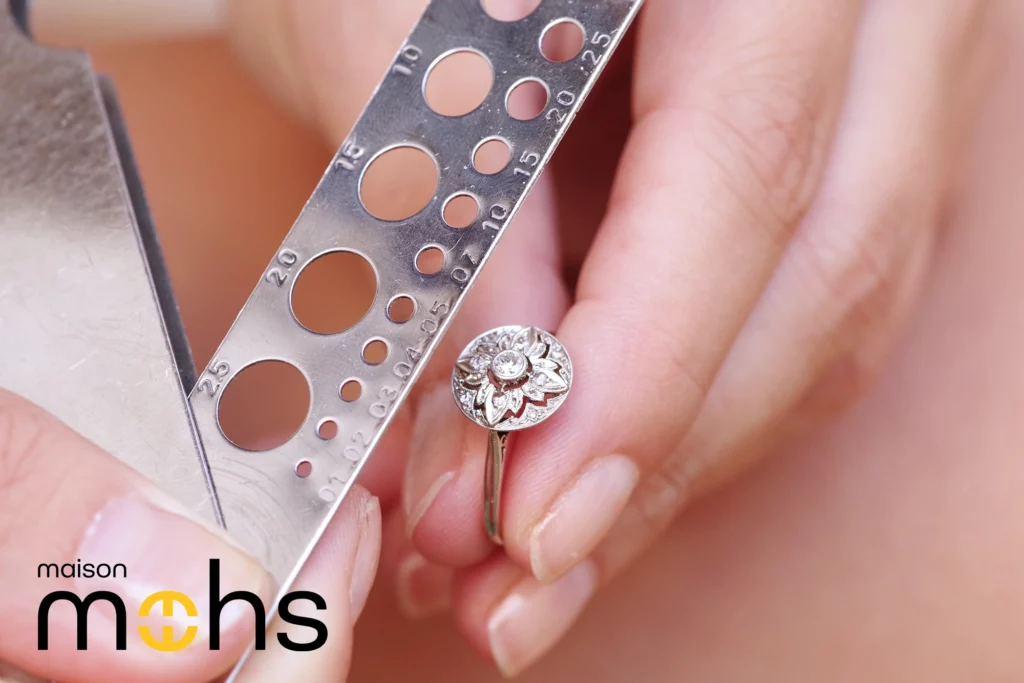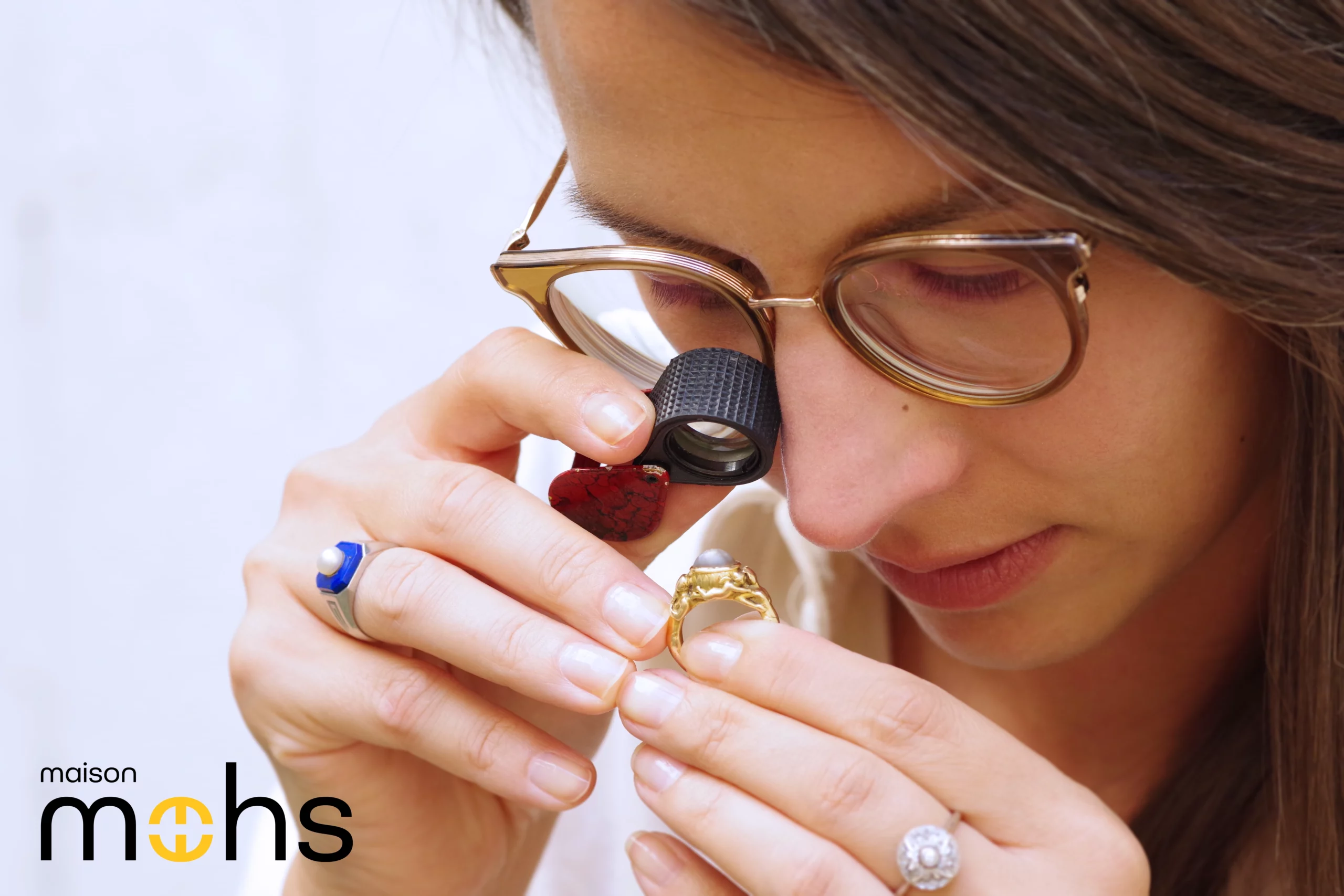
When you want to purchase antique jewellery from a specialized website, gallery, or jewellery store, you may have questions like, “How can I be sure it’s really gold?” or “How can I verify if it’s a real diamond?”
This article will explain how we appraise jewelry at Maison Mohs and, more importantly, how jewelry should be appraised in general.
Who Appraises Antique Jewelry?
There are multiple “experts” in the world of jewelry: gemologists, appraisers, antique dealers, auctioneers, and jewelers. We’ll provide details on what you need to know about the seller of your jewelry.
The Gemologist
Being a gemologist is good; being an art historian specializing in jewelry is even better! In fact, Maison Mohs has two art historians on its team. The two founders of Maison Mohs, Céline Moret and Angéline Chanson, both studied art history in Paris and Lyon. This complements the expertise in precious stones.
These educations are essential for understanding and analyzing jewelry as a whole. It requires a real method of work and research to assess the origin and period of a piece of jewelry or even to find the artist behind an antique piece, either by going to a specialized institute or by making specific requests in the library.
The Gemologist Specializing in Jewelry History
Être gemmologue, c’est bien ; être historien de l’art spécialisé en bijoux, c’est mieux ! En effet, Maison Mohs compte deux historiennes de l’art dans ses murs. Les deux fondatrices de Maison Mohs, Céline Moret et Angéline Chanson, ont toutes deux faits leurs hautes études en histoire de l’art à Paris et à Lyon. Cela permet de compléter les compétences d’expertises en pierres précieuses.
Ces formations sont essentielles pour bien comprendre et analyser un bijou dans son ensemble. Cela demande une vraie méthode de travail et de recherche pour évaluer l’origine et l’époque ou encore retrouver l’artiste d’un bijou ancien. Soit en allant dans un institut spécialisé, soit en faisant des demandes spécifiques en bibliothèque.
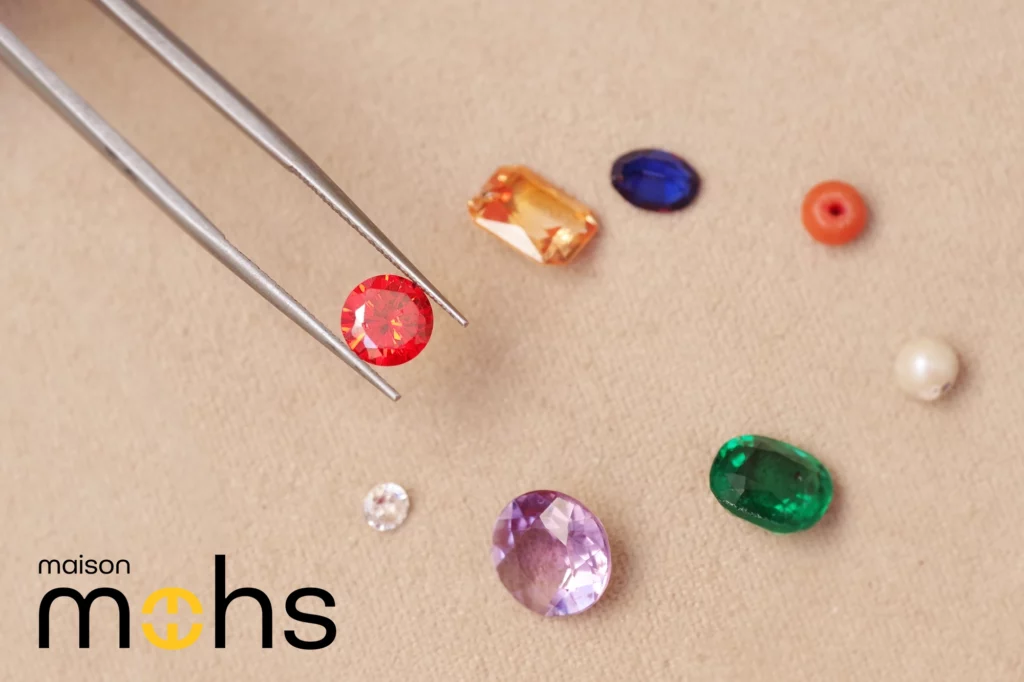
Other Jewelry Professionals
Gemmologists, auction experts, antique dealers, auctioneers, and jewelers all have knowledge about jewelry and precious stones. However, these professionals do not have comprehensive training in jewelry: gemstone study, understanding of style, origin, and period, and learning jewelry techniques. This inevitably results in incomplete expertise, which we detail below:
The Antique Dealer
An antique dealer has general knowledge and may sometimes specialize in a particular field. If their specialization is not in antique jewelry, the authenticity of gemstones is not necessarily guaranteed. Ask them if the gemstones come with a certificate of authenticity or if they have been authenticated by a gemologist. If the answer is negative, you have no certainty that the jewelry you are buying actually contains the gemstones mentioned by the antique dealer.
The Auctioneer
Like an antique dealer, an auctioneer is a professional in art objects. They have a wide range of expertise but may not have a deep specialization in jewelry and gemstones. You can buy jewelry from an auction house in the following situations:
- The auctioneer consults an expert in antique jewelry. In this case, the expert is mentioned in the auction catalog.
- The auctioneer has specialized and completed gemologist training.
Otherwise, you take a risk when buying or selling jewelry at auctions, as the jewelry may be misidentified, which often leads to a loss of money.
The Jeweler
A jeweler is a craftsman who creates, repairs, cleans, and sells new jewelry. They create jewelry using various precious materials such as gold, silver, and platinum. They design and assemble these materials to create rings, necklaces, bracelets, earrings, brooches, and other jewelry pieces. Jewelers possess technical knowledge and expertise in precious metals (gold, platinum, and silver) and have some knowledge of setting (although it is a separate profession).
However, a family jeweler typically has very little expertise in the history of jewelry and gemmology (the study of gemstones), as they have not undergone additional training to date a piece of jewelry or certify a stone.
The Gemmologist
A gemmologist, specialized only in gemstones (cut and polished stones used in jewelry and ornaments), often complements their profession with another field. You can find gemmologists among gemstone dealers, lapidaries (those who cut gemstones), experts in antique jewelry, and occasionally among insurance experts, auctioneers, and jewelers.
It may seem strange to think that these professionals in the world of jewelry are not complete experts. However, this is the reality. It is important to ensure that your contact has a solid cultural foundation and either has gemologist training or has a gemmologist on their team.
Appraising Antique Jewelry
When we have an antique piece of jewelry in our possession, several steps are necessary to appraise and determine the value of the piece. These steps are crucial and allow you to purchase jewelry with confidence and peace of mind.
Analysis of Precious Materials: Gold, Platinum, and Silver
First, our gemmologist, equipped with a valuable 10x magnifying glass, examines the precious metal of the jewelry. It’s important to know that any jewelry made of gold, silver, or platinum weighing more than 3 grams and put up for sale must be hallmarked. When our expert observes a hallmark, also called a “guarantee mark,” she carefully examines it to determine which hallmark it is. When no hallmark is present on the jewelry, it is sent to customs.
Hallmarks in France
In France, there are numerous hallmarks to differentiate jewelry from different periods, regions, and materials. At Maison Mohs, we detail the common hallmarks engraved on the jewelry and mentioned in our item descriptions (see the hallmark table below):
- Gold Hallmarks: seahorse (24 karat gold), eagle head, owl (18 karat gold), shell hallmark (14 karat gold), clover hallmark (9 karat gold)
- Platinum Hallmarks: dog’s head and mascaron (950 fineness)
- Silver Hallmarks: profile of Minerva, swan, and wild boar (925 and 800 fineness)
- Other Hallmarks: ET (low-grade gold), combination of eagle and wild boar (partly gold and partly silver)
- There are other older hallmarks, such as the rooster, horse, ram, rhinoceros, bulldog, lion, etc. These are special hallmarks dating back to before the 19th century, differentiating jewelry made in Paris from jewelry made in the provinces, smaller gold jewelry (rings) from larger ones (necklaces/chains/bracelets), and distinguishing different French regions.
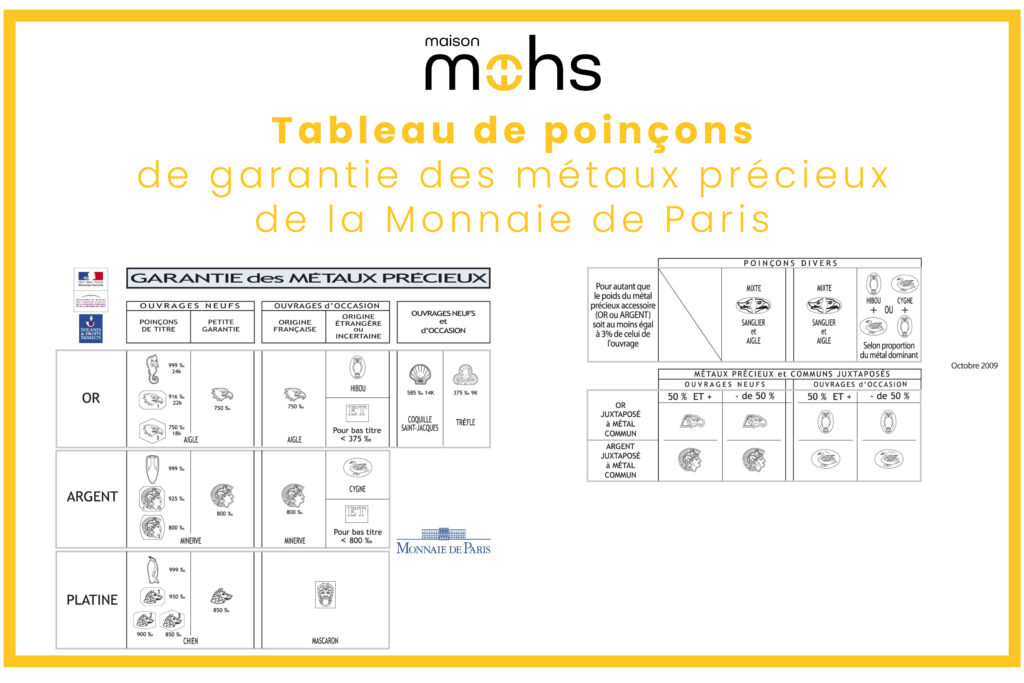
Customs Inspection
When no hallmark has been engraved on jewelry weighing more than 3 grams, the seller is legally required to have it marked at a customs office. This serves two purposes:
- Verification of the precious metal fineness: The buyer needs to know if they are purchasing an antique ring in 18-karat gold or a ring in 9-karat gold (the latter is worth much less as it contains significantly less gold).
- Compliance with legislation: If you buy a ring on a platform and the hallmark is not mentioned, you have the right to ask the question.
- Exception: Some jewelry is exempt from hallmarks if marking it would risk damaging it.
At Maison Mohs, all our jewelry is hallmarked and verified by the guarantee office. Our jewelry is generally French and made of 18-karat gold (750 fineness). Our item descriptions mention all the hallmarks on jewelry weighing more than 3 grams.
Appraisal of Gemstones
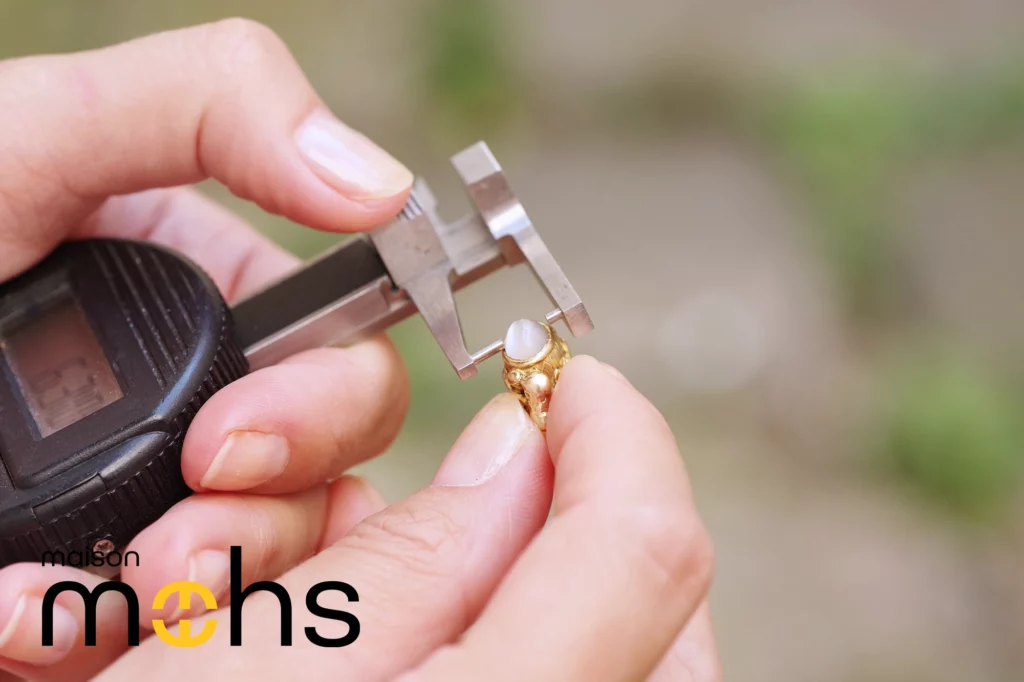
Appraising a gemstone by a gemmologist is a meticulous process that takes place in several stages. Here is a general overview of these stages:
- Client Identification: The gemmologist begins by gathering information about the client, their expectations, and the reasons for the appraisal. They may also check the origin of the gemstone if relevant.
- Initial Visual Examination: The appraisal starts with a visual examination of the gemstone. The gemmologist inspects the gem with the naked eye to identify initial characteristics such as color, size, shape, and visible inclusions.
- Preliminary Identification: The gemmologist uses gemology tools such as a loupe and a refractometer (for refractive indices) to determine the nature of the stone.
- Weight: The gemstone is weighed using a precision scale to determine its carat weight.
- Measurements: The gemmologist takes precise measurements of the stone using a gauge to determine its dimensions (length, width, depth) and calculate its volume.
- Color Evaluation: The color of the stone is evaluated using specific color standards for the particular variety of gemstone. Comparisons with reference samples may be made.
- Clarity and Inclusions: The gemmologist carefully examines the stone under a 10x loupe to look for inclusions (flecks, crystals, fractures, etc.), scratches, chips, or other internal or external imperfections. They then assign a clarity grade based on the quantity and visibility of these imperfections.
- Cut Quality: The quality of the stone’s cut is evaluated. This includes assessing symmetry, light reflection, brilliance, and sparkle of the stone. Quality and Value
- Assessment: Using all the information gathered, the gemmologist assigns a quality assessment to the gemstone. This assessment is typically based on the “4 Cs” for diamonds (Carat, Color, Clarity, Cut), but other specific criteria apply to other types of gemstones.
Appreciation of the Jewelry in Its Era
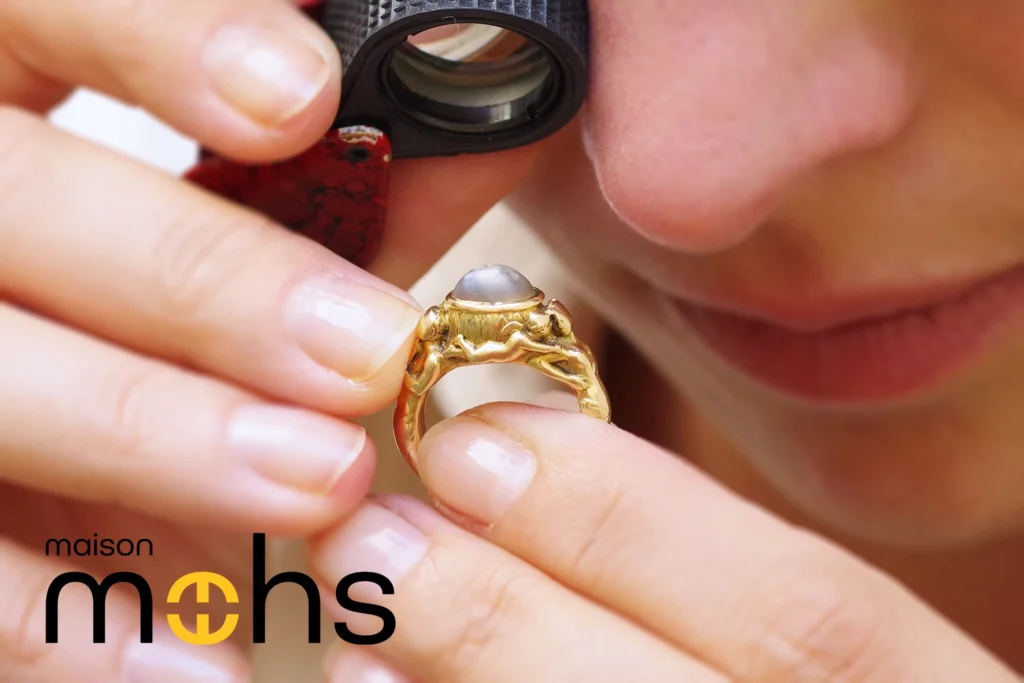
Appraising the age and geographical origin of a piece of jewelry is a complex process that requires expertise in gemmology, art history, and documentary research. Here are the general steps for this expertise:
- Naked Eye Examination: The expert begins with a visual examination of the jewelry. They examine the piece’s characteristics, such as design, materials, manufacturing techniques, and any hallmarks or signatures.
- Identification of Materials: The expert identifies the materials used in the jewelry, including precious metals (gold, silver, platinum), gemstones, pearls, etc.
- Evaluation of Manufacturing Techniques: The expert examines the jewelry’s manufacturing methods, including soldering, setting, engraving, and stone cutting. Styles and manufacturing techniques can provide clues about the era and presumed geographical origin.
- Documentary Research: The expert conducts documentary research to find information about similar jewelry from the same period or region. This may involve consulting archives, specialized books in libraries, auction catalogs, and online databases.
- Hallmarks and Signatures: If the jewelry has hallmarks or signatures, the expert examines them to try to identify and link them to specific periods or places.
- Stylistic Analysis: The expert analyzes the style of the jewelry, examining patterns, ornaments, and decorative details. They compare these elements to artistic and cultural trends of the era and presumed place of origin.
- Assessment of Age: By combining all the collected information, the expert assesses the likely age of the jewelry, providing a range of possible ages.
- Assessment of Geographical Origin: Based on stylistic clues, materials used, and available documentation, the expert attempts to determine the likely geographical origin of the jewelry.
Certificate of Authenticity
Finally, the gemmologist compiles all the information and findings into a detailed appraisal report. This report includes a comprehensive description of the stone and jewelry. This certificate is usually provided to the client for future use, such as selling, insuring, or purchasing a gemstone.
It’s important to note that determining the age and geographical origin of a piece of jewelry can be complex, and it may be necessary to consult experts specialized in fields such as art history, antique jewelry, and gemmology to obtain precise results.
Selling Antique Jewelry
La vente de bijoux anciens allie expertise, restauration, mise en valeur, évaluation et une relation de confiance cruciale entre vendeur et amateur de bijou.
Cleaning
It starts with meticulous cleaning of antique jewelry to reveal their original beauty, removing dirt and residues that may have dulled them and restoring the precious metal’s shine.
Possible Restorations
If necessary, restorations such as restringing pearl necklaces or replacing gemstones are performed to ensure their durability and preserve their authenticity.
Presentation
Attractive presentation of jewelry through high-quality photographs, videos, and detailed descriptions is essential to attract potential buyers and collectors.
Valuation
Careful valuation of the price, taking into account age, rarity, material quality, and gemstones, is crucial for a fair transaction.
Trustworthy Relationship
Ultimately, buying and selling rely on a strong relationship of trust between the seller and the buyer, based on authenticity and transparency, allowing antique jewelry to continue to shine and be appreciated through the generations.
